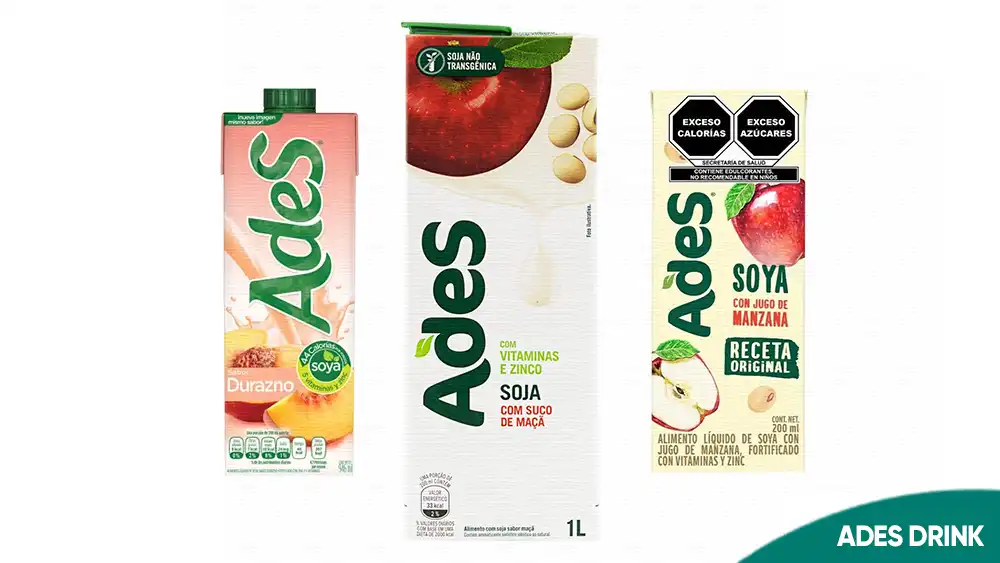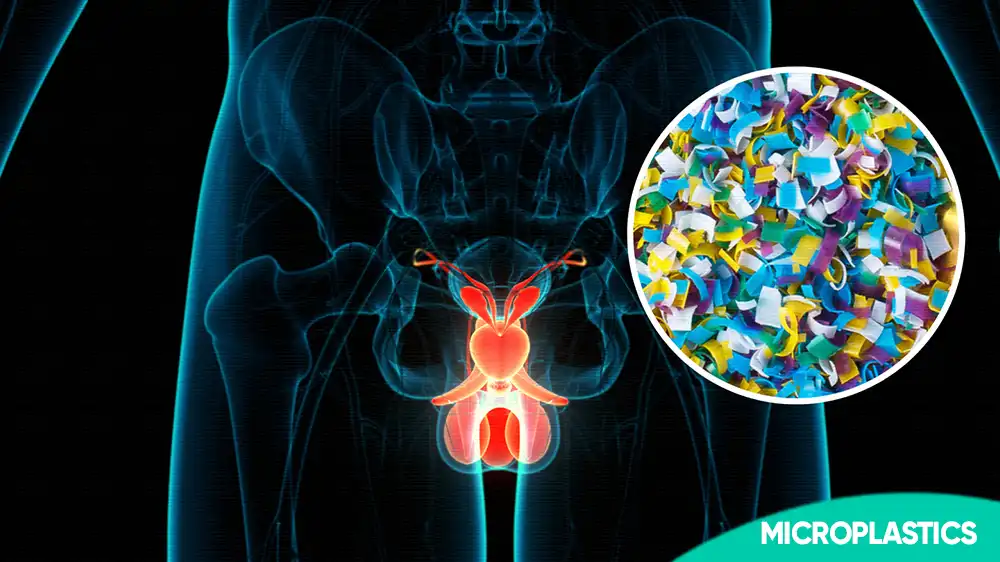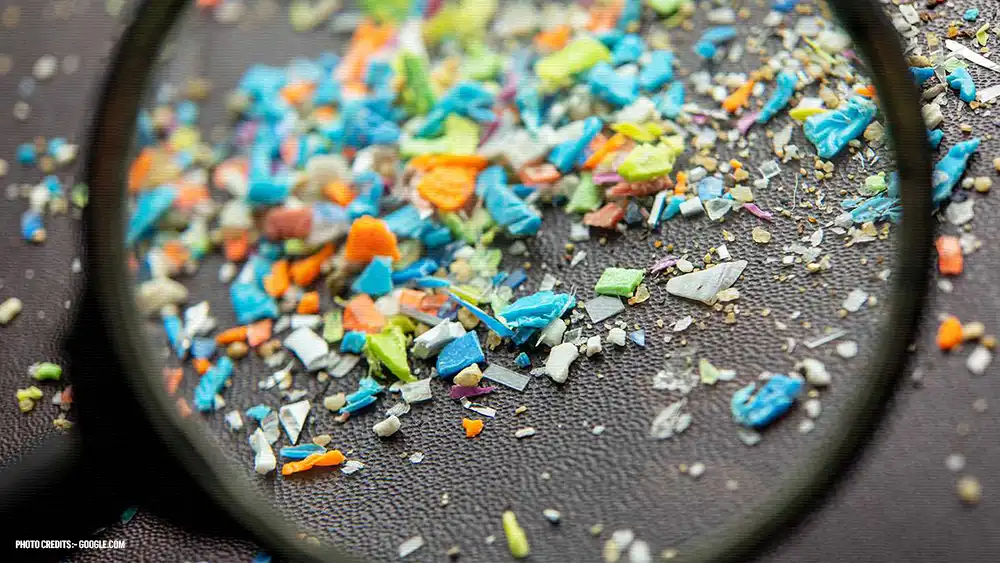
HEALTH BLOG
Microplastics in Human Testicles: Understanding the Reproductive Health Implications
-
 Rahul Priydarss
Rahul Priydarss - May 21, 2024
Discover the pervasive issue of microplastics infiltrating our environment and bodies, including human testicles. Learn about the health risks, how microplastics enter our systems, and measures to reduce exposure. Explore innovative plastic alternatives and the latest research on microplastics’ impact on reproductive health. Join the collective effort to combat microplastic pollution and safeguard our health and environment.
What Are Microplastics:
Microplastics, tiny plastic fragments less than 5 millimeters in diameter, have become undeniable in our environment. They’ve been found in the deepest ocean trenches, the vast expanse of the Arctic, and even fluttering in the air we breathe. But perhaps most concerning is their growing presence within us – microplastics have been detected in human blood, lungs, placentas, and even breast milk.
This discovery raises a multitude of questions. How are these miniscule particles entering our bodies? What potential health risks do they pose? While research is ongoing, there are still more unknowns than definitive answers.

Table of Contents
How Do Microplastics Enter the Human Body:
Microplastics, those miniscule plastic fragments plaguing our environment, have found a way to infiltrate our bodies through a surprising number of routes. Here’s a deeper dive into these sneaky pathways.
1. Ingestion: A One-Way Ticket to the Gut
Seafood Feast with an Unwanted Side Dish: Microplastics readily enter the food chain. They can leach from plastic packaging into food and beverages, contaminating everything from bottled water to processed meats. Additionally, marine life like fish and shellfish can ingest microplastics directly, concentrating them in their tissues. When we consume these contaminated seafood products, we unwittingly ingest microplastics as well. Studies estimate an average adult might consume thousands of microplastics annually, with even higher numbers for those who consume significant amounts of seafood.
From Farm to Fork, Microplastics Along the Way: Microplastics present in the environment can contaminate agricultural soil and water used for irrigation. Plants can absorb these tiny particles, raising concerns about their presence in fruits and vegetables we consume. Furthermore, abrasion during food processing and packaging can introduce microplastic fragments into our food.
2. Inhalation: Microplastics Take Flight
Microfibers on the Loose: Synthetic clothing, a staple in many wardrobes, sheds tiny microfibers during washing and everyday wear. These microscopic fibers become airborne and can be easily inhaled, especially during activities that stir up dust like vacuuming or making the bed.
Car Tires Leaving Their Mark: The friction between car tires and roads generates microplastics from tire wear. These particles get released into the air, posing a potential inhalation risk, particularly in areas with heavy traffic.
Industrial Emissions: A Microplastic Cloud: Certain industrial activities like plastic manufacturing and processing can release microplastics into the air. People living or working near these facilities may be at increased risk of inhaling them.
3. Skin Contact: A Direct Route
Exfoliating with Microplastics? Some personal care products contain microplastic beads, particularly exfoliating scrubs and some toothpastes. During use, these tiny plastic particles come into direct contact with the skin and may be absorbed to a limited extent.
Synthetic Fabrics: Not Just Threads: While comfortable and versatile, synthetic clothing can shed microplastic fibers. These fibers can adhere to the skin and potentially be absorbed, although the exact extent of this is still under investigation.
Microplastics in Food and Water:
Microplastics, tiny plastic fragments less than 5 millimeters in size, have become an unwelcome guest in our food and water supply. Their presence raises concerns about potential health risks and the overall health of our environment. Here’s a closer look at how microplastics infiltrate our food and water.
1. Contaminated Oceans and contaminated Seafood: The vast expanse of our oceans has unfortunately become a dumping ground for plastic waste. Microplastics from various sources, including plastic bags, bottles, and industrial waste, end up in the ocean. Marine life like fish, shellfish, and crustaceans ingest these microplastics directly or through their food source (plankton). When we consume these contaminated seafood products, we unwittingly ingest microplastics as well.
2. From Land to Sea: Microplastics in the Food Chain: Microplastics on land can also find their way into the food chain. Agricultural runoff containing microplastics from sources like plastic mulch films used in farming can contaminate waterways and eventually reach the ocean. Plants can also absorb microplastics present in the soil or irrigation water, raising concerns about their presence in fruits and vegetables we consume.
3. Plastic Packaging: A Double-Edged Sword: Plastic packaging plays a vital role in preserving and transporting food. However, it can also be a source of microplastic contamination. Microplastic particles can leach from plastic packaging into food and beverages over time, especially under certain storage conditions like high temperatures.
4. Microplastics in Drinking Water: Microplastics have been detected in various sources of drinking water, including bottled water, tap water, and even groundwater. The source of contamination can vary. Microplastics might be present in the source water itself, or they could be introduced during the treatment process through abrasion from pipes or filters. While filtration systems can remove some microplastics, the effectiveness can vary depending on the size and type of microplastics.
Health Risks of Microplastics:
Microplastics, defined as plastic particles less than 5 millimeters in diameter, have become a pervasive environmental pollutant with potential implications for human health. These tiny plastic fragments originate from the degradation of larger plastic items, as well as from direct sources like microbeads in personal care products. The widespread presence of microplastics in water, air, and food has raised significant concerns about their impact on human health. Here are some of the primary health risks associated with microplastics.
1. Ingestion and Accumulation: Microplastics have been detected in a variety of foods, including seafood, table salt, honey, and even drinking water. When ingested, these particles can accumulate in the digestive system. Although most microplastics are likely excreted, some studies suggest that very small particles (nanoplastics) could cross the gut barrier and enter the bloodstream, potentially reaching other organs.
2. Toxic Chemical Exposure: Microplastics can act as carriers for harmful chemicals. These include additives used in plastic manufacturing, such as phthalates and bisphenol A (BPA), which are known endocrine disruptors. Additionally, microplastics can adsorb environmental pollutants like heavy metals and persistent organic pollutants (POPs) from their surroundings. When ingested or inhaled, these chemicals can leach from the plastic particles, posing risks such as hormonal imbalances, reproductive issues, and developmental problems.
3. Inflammatory and Immune Responses: Exposure to microplastics may trigger inflammatory responses in the body. Laboratory studies on animals and cell cultures have shown that microplastics can induce oxidative stress, inflammation, and immune responses. These reactions could potentially lead to tissue damage and are linked to a range of health issues, including cardiovascular diseases and autoimmune conditions.
4. Respiratory Problems: Microplastics are not only ingested but also inhaled. Atmospheric microplastics are present in both indoor and outdoor environments. Inhalation of these particles can lead to respiratory problems. Studies have shown that inhaled microplastics can deposit in the lungs, causing inflammation and potentially contributing to chronic respiratory conditions like asthma and bronchitis.
5. Potential Carcinogenic Effects: Some studies have raised concerns about the potential carcinogenic effects of microplastics. The chronic inflammation caused by microplastic exposure could theoretically increase the risk of cancer. Moreover, the toxic chemicals associated with microplastics, some of which are known carcinogens, might exacerbate this risk. However, more research is needed to establish a definitive link between microplastics and cancer.
6. Impact on Gut Microbiota: The gut microbiota plays a crucial role in maintaining overall health, including immune function and digestion. Emerging research suggests that microplastics might alter the composition and function of the gut microbiota. Disruptions in the gut microbiome have been associated with a range of health issues, from metabolic disorders to mental health conditions.
Microplastics in the Human Testicles:
Research has shown that microplastics can accumulate in various organs and tissues of the body, including the testicles. This accumulation raises concerns about the potential health effects on male reproductive health.
1. Spermatogenesis Disruption: The presence of microplastics in the testicles can interfere with spermatogenesis, the process of sperm production. Studies in animals have shown that exposure to microplastics can lead to reduced sperm quality, lower sperm counts, and impaired sperm motility. These effects could potentially contribute to male infertility.
2. Hormonal Disruption: Microplastics contain additives like phthalates and bisphenol A (BPA), which are known endocrine disruptors. These chemicals can mimic or interfere with the body’s natural hormones, including testosterone, which plays a crucial role in male reproductive health. Disruption of hormonal balance in the testicles can affect sperm production and fertility.
3. Inflammatory Responses: Accumulation of microplastics in the testicular tissue can trigger inflammatory responses. Chronic inflammation in the testicles can damage the delicate structures involved in sperm production and maturation. Inflammation may also disrupt the blood-testis barrier, which regulates the microenvironment of the testicles essential for spermatogenesis.
4. DNA Damage: Exposure to microplastics in the testicles may lead to DNA damage in sperm cells. DNA damage can affect the integrity and function of sperm, potentially increasing the risk of genetic abnormalities in offspring. This damage may also contribute to male infertility and reproductive disorders.
5. Temperature Regulation: The testicles require a specific temperature range to produce healthy sperm. Accumulation of microplastics in testicular tissue may interfere with temperature regulation, leading to overheating or impaired cooling mechanisms. Changes in testicular temperature can negatively impact sperm production and quality.
Potential Implications for Reproductive Health:
The accumulation of microplastics in the environment has raised concerns about potential implications for reproductive health, affecting both males and females. Here are some of the potential effects.
1. Male Reproductive Health:
Sperm Quality: Research suggests that exposure to microplastics may lead to reduced sperm quality, including decreased sperm count, motility, and morphology.
Hormonal Disruption: Microplastics contain endocrine-disrupting chemicals that can interfere with hormone regulation, potentially affecting testosterone levels and sperm production.
Testicular Damage: Accumulation of microplastics in the testicles can induce inflammation and oxidative stress, leading to tissue damage and compromising sperm production.
DNA Damage: Microplastic exposure may cause DNA damage in sperm cells, increasing the risk of genetic abnormalities in offspring.
2. Female Reproductive Health:
Hormonal Imbalance: Endocrine-disrupting chemicals found in microplastics can disrupt estrogen and progesterone levels, affecting menstrual cycles, ovulation, and fertility.
Pregnancy Complications: Exposure to microplastics during pregnancy may pose risks to fetal development, including potential effects on the placenta and the developing fetus.
Endometriosis: Some studies suggest a possible link between microplastic exposure and endometriosis, a painful condition where tissue similar to the lining of the uterus grows outside the uterus.
3. Fertility Issues:
Infertility: Both males and females may experience reduced fertility due to the effects of microplastics on reproductive organs, hormone levels, and gamete quality.
Reproductive Disorders: Long-term exposure to microplastics may contribute to the development of reproductive disorders such as polycystic ovary syndrome (PCOS) and testicular dysgenesis syndrome (TDS).
4. Transgenerational Effects:
Epigenetic Changes: Microplastic exposure may induce epigenetic modifications in germ cells, potentially affecting the health and reproductive outcomes of future generations.
Inheritance of Health Risks: Changes in sperm or egg cells caused by microplastic exposure could be passed on to offspring, leading to an increased risk of reproductive and developmental abnormalities.

Detecting Microplastics in Human Tissues:
Detecting microplastics in human tissues presents significant challenges due to their small size, diverse composition, and widespread distribution. However, researchers have developed several methods to identify and quantify microplastics in biological samples. Here are some common techniques.
1. Microscopic Analysis:
Optical Microscopy: Microplastics can be visually identified using optical microscopes. However, this method is limited by the small size of microplastics and may not detect particles smaller than the resolution limit of the microscope.
Micro-Fourier Transform Infrared Spectroscopy (μ-FTIR): FTIR spectroscopy can identify the chemical composition of microplastics by analyzing their infrared spectra. This technique is valuable for confirming the presence of microplastics and characterizing their polymer types.
2. Raman Spectroscopy:
Confocal Raman Microscopy: Raman spectroscopy provides molecular information about the composition of microplastics by measuring the scattering of laser light. Confocal Raman microscopy enables the spatial mapping of microplastics within biological samples, offering valuable insights into their distribution.
3. Microplastic Extraction:
Chemical Digestion: Biological tissues can be chemically digested to release microplastics embedded within them. Following digestion, microplastics can be isolated and analyzed using microscopy or spectroscopic techniques.
Density Separation: Density-based separation techniques, such as density gradient centrifugation or floatation, can be used to isolate microplastics from biological matrices. This method is particularly useful for samples with high organic content.
4. Analytical Chemistry Techniques:
Gas Chromatography-Mass Spectrometry (GC-MS): GC-MS can detect and quantify organic contaminants associated with microplastics, providing insights into potential chemical exposures.
Liquid Chromatography-Mass Spectrometry (LC-MS): LC-MS is useful for analyzing additives and plasticizers associated with microplastics, which may leach into biological tissues.
5. Nanoparticle Tracking Analysis (NTA):
NTA: NTA can measure the size and concentration of nanoparticles, including microplastics, in biological samples. This technique tracks the Brownian motion of particles suspended in a liquid medium, providing information about their size distribution.
6. Immunohistochemistry:
Antibody Staining: Immunohistochemical staining with specific antibodies can be used to detect microplastics in tissue sections. Antibodies targeting common plastic polymers or surface markers can facilitate the identification of microplastics within cells or tissues.
Measures to Reduce Microplastic Exposure:
Reducing microplastic exposure requires collective efforts at individual, societal, and policy levels. Here are some measures to mitigate microplastic pollution and minimize human exposure.
1. Reduce Single-Use Plastics:
Use Reusable Alternatives: Instead of using disposable plastic bags, water bottles, and containers, opt for reusable options made from materials like cloth, glass, stainless steel, or bamboo. These alternatives reduce the demand for single-use plastics and help minimize plastic waste.
Avoid Disposable Packaging: Choose products with minimal or biodegradable packaging to reduce plastic waste generation. Buying in bulk or choosing products with refillable packaging can also help minimize plastic packaging.
2. Minimize Microplastics in Personal Care Products:
Check Ingredient Lists: Be mindful of the ingredients in personal care products such as toothpaste, scrubs, and cosmetics. Avoid products containing microplastic ingredients like polyethylene (PE), polypropylene (PP), and nylon.
Choose Natural Exfoliants: Opt for natural exfoliants like ground nut shells, apricot kernels, or bamboo powder instead of products containing synthetic microbeads. Natural alternatives are biodegradable and do not contribute to microplastic pollution.
3. Proper Waste Management:
Recycle Properly: Sort and recycle plastic waste according to local recycling guidelines. Proper recycling helps prevent plastic from ending up in landfills or the environment, where it can break down into microplastics.
Reduce Littering: Dispose of trash in designated bins and avoid littering in natural environments, especially near water bodies. Littered plastics can be carried by wind and water, eventually fragmenting into microplastics and contaminating ecosystems.
4. Support Legislation and Policies:
Ban Microbeads: Advocate for regulations banning the use of microbeads in personal care products. Several countries and regions have implemented bans or restrictions on microbeads to reduce their environmental impact.
Implement Plastic Bans: Support legislative efforts to ban or restrict the production and use of single-use plastics. Bans on items like plastic bags, straws, and styrofoam containers help reduce plastic pollution and encourage the adoption of more sustainable alternatives.
5. Promote Eco-Friendly Practices:
Encourage Sustainable Consumption: Choose products with minimal packaging, opt for reusable items, and support brands committed to sustainability. By making conscious choices as consumers, individuals can reduce their overall plastic footprint.
Support Eco-Friendly Businesses: Patronize businesses that prioritize environmental sustainability and offer eco-friendly products and packaging. Supporting sustainable businesses sends a message to industries and encourages the adoption of environmentally responsible practices.
6. Raise Awareness and Education:
Educate Others: Share information about microplastic pollution and its impacts on the environment and human health. Educate friends, family, and communities about ways to reduce plastic consumption and minimize microplastic pollution.
Promote Behavior Change: Encourage individuals to rethink their consumption habits and adopt eco-friendly practices in their daily lives. Small changes in behavior, such as using reusable bags or choosing plastic-free alternatives, can collectively make a significant difference in reducing microplastic pollution.
7. Support Research and Innovation:
Invest in Research: Support scientific research aimed at understanding the sources, distribution, and impacts of microplastics. Research funding helps advance knowledge about microplastic pollution and informs evidence-based solutions.
Develop Sustainable Solutions: Encourage innovation in materials science and waste management to develop sustainable alternatives to conventional plastics and methods for mitigating microplastic pollution. Investing in technologies for plastic recycling, biodegradable materials, and pollution prevention supports progress toward a plastic-free future.
Innovations in Plastic Alternatives:
In recent years, there has been a surge in innovations aimed at developing alternative materials to conventional plastics. These innovations seek to address the environmental challenges posed by plastic pollution while maintaining the functionality and versatility of plastic-based products. Here are some notable advancements in plastic alternatives.
1. Bioplastics:
Plant-Based Polymers: Bioplastics are derived from renewable biomass sources such as plants, algae, or agricultural byproducts. These materials offer similar properties to conventional plastics but are biodegradable or compostable, reducing their environmental impact.
Polylactic Acid (PLA): PLA is a bioplastic made from fermented plant sugars, such as corn starch or sugarcane. It is used in packaging, disposable tableware, and 3D printing applications. PLA products can be composted under industrial composting conditions.
2. Mycelium-based Materials:
Fungal Biomaterials: Mycelium, the root-like structure of fungi, can be grown into strong and lightweight materials with properties similar to plastics. Mycelium-based products are biodegradable, compostable, and can be molded into various shapes for packaging, insulation, and building materials.
3. Edible Packaging:
Food-Based Wrappers: Edible packaging materials made from natural ingredients like seaweed, starches, or fruit skins offer a sustainable alternative to single-use plastics. These materials are biodegradable, edible, and can help reduce plastic waste in food packaging.
4. Recycled Plastics:
Post-Consumer Recycled (PCR) Plastics: Recycled plastics are sourced from post-consumer waste and processed into new products. Advancements in recycling technologies enable the production of high-quality PCR plastics for use in various applications, including packaging, textiles, and construction.
5. Biodegradable Polymers:
Synthetic Biodegradable Polymers: Researchers are developing synthetic polymers that are designed to degrade in the environment under specific conditions, such as exposure to sunlight, heat, or microbial activity. These polymers offer a solution for reducing plastic pollution while maintaining product durability and functionality.
6. Algal Bioplastics:
Algae-Based Materials: Algae-derived bioplastics utilize microalgae or seaweed as feedstock for producing biodegradable polymers. Algal bioplastics have potential applications in packaging, textiles, and biomedical materials, offering a sustainable alternative to petroleum-based plastics.
7. Hybrid Materials:
Bio-Based Composites: Hybrid materials combine biodegradable polymers with natural fibers or fillers to enhance mechanical properties and reduce environmental impact. These bio-based composites are used in automotive parts, construction materials, and consumer goods.
8. Nanocellulose:
Cellulose Nanofibers: Nanocellulose derived from plant sources such as wood pulp or agricultural residues offers a sustainable alternative to synthetic polymers. Nanocellulose-based materials are lightweight, strong, and biodegradable, with applications in packaging, paper products, and biomedical devices.
Latest Study on Microplastics in Human Testicles (May 2024):
The most recent study you’re referring to likely is the one published in the journal Toxicological Sciences in May 2024 titled “Microplastics Found in Human and Canine Testicles” by researchers from the University of New Mexico.
Here’s a breakdown of the key findings from this study:
Microplastics in Every Sample: The study examined tissue samples from 23 human testes obtained through postmortem examinations and 47 testes from pet dogs. Alarmingly, microplastics were found in every single sample analyzed.
Types of Microplastics: The most common type of microplastic identified as polyethylene (PE), a plastic commonly used in plastic bags and bottles. Polyvinyl chloride (PVC), another widely used plastic, was also detected.
Higher Concentration in Humans: Interestingly, the average concentration of microplastics was nearly three times higher in human testicular tissue compared to dog testes. This finding warrants further investigation to understand the potential reasons behind this difference.
Potential Link to Sperm Count: While the study didn’t establish a definitive cause-and-effect relationship, the authors suggest a possible link between microplastic presence and declining sperm counts observed in men globally.
FAQs about Microplastics in Human Testicles:
A1: Microplastics can enter the body through ingestion, inhalation, and possibly absorption through the skin. Once inside, they can travel through the bloodstream and accumulate in various organs, including the testicles.
A2: Microplastics in the testicles can potentially disrupt hormone production and affect sperm quality, leading to fertility issues and other health problems.
A3: Currently, there is no known method to remove microplastics from the body completely. The focus is on reducing exposure and understanding the long-term health impacts.
A4: There are no established safe levels of microplastics in food and water. Ongoing research aims to determine the potential health risks associated with different exposure levels.
A5: Individuals can reduce their exposure by using reusable products, choosing natural fibers, supporting environmental initiatives, and advocating for policy changes to reduce plastic production and waste.

-Please remember, to always consult with healthcare professionals or Doctors for personalised advice related to medical conditions.
Conclusion:
Microplastics have become pervasive in our environment and are now found within human tissues, including testicles. Their potential health risks include hormonal disruption, inflammation, and reproductive issues. Reducing exposure requires minimizing single-use plastics, adopting eco-friendly practices, and supporting innovative alternatives. Recent studies underscore the urgent need for further research to understand and mitigate these impacts. Collective efforts at individual, societal, and policy levels are essential to address the growing problem of microplastic pollution.




